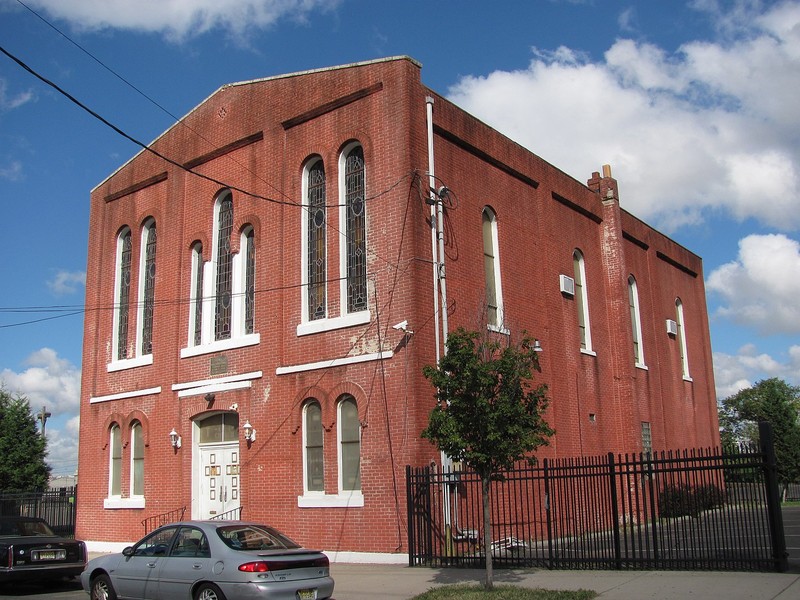Macedonia African Methodist Episcopal Church
Introduction
Text-to-speech Audio
Images
Macedonia African Methodist Episcopal Church of Camden, New Jersey

Backstory and Context
Text-to-speech Audio
Macedonia African Methodist Episcopal (AME) Church (circa 1832) operated as part of the Underground Railroad (UGRR) by assisting fugitive slaves from Salem and Cumberland Counties, as well as from Philadelphia. The church opened in what was once Fettersville, Camden's earliest Black settlement and first urban neighborhood. The historic church building opened in 1884 and survives today as a pillar of Camden's oldest Black institution. Over the years, the church has functioned as a place of worship, community events, a source of social activism, and otherwise acted as the heart of the local, African American community.
The establishment of the church in 1832 fostered an impressive growth of African Americans in Fettersville (southern Camden). By 1840, the town supported 297 African Americans, with roughly 100 of them under ten-years-old. The African American population increased to 725 in 1850 (four years after the state abolished slavery). As the community grew during the 1840s, the church was the state's southernmost station on the UGRR, led by arguably the state's most active UGRR leader, Rev. Thomas Clement Oliver, church pastor. In 1847, one year after New Jersey abolished slavery, slave hunters passed the church in a wagon containing an African American who cried for help. The congregation responded to the man's cries by pouring into the street to intercede, forcing the slave hunters to flee and release the man. The incident marks one of many actions taken by Macedonia AME to save, hide, and protect both fugitive slaves and free Black persons from slave hunters.
Camden possessed the largest African American population in the state within fifteen years after the Civil War. The congregation's growth pushed its members to plan again to construct a much larger facility, which opened in 1884. However, while the population grew, the percentage of African Americans shrunk each decade, falling from roughly 17% in 1850 to 7% in 1885. As such, the church proved highly important to the growing, thriving community that also existed as a minority faced with racial injustices; the church served as both a place of worship and a community center.
From 1880 - 1920, African Americans migrated in great numbers from the South to the Philadelphia metro area, including Camden. Their arrival, coupled with abounding European immigration, profoundly affected the area's size, demographics, and economics; Camden developed into a vibrant suburban city. Concurrently, during the first two decades of the twentieth century, the Macedonia AME church engaged politically, aligning with the Republican Party and often working with other Philadelphia-area African American groups. Thus, the church influenced many of the local laws that provided for better civil rights. Many of its members went on to take such civic roles such as postal workers, police officers, and one member became a Justice of the Peace. Many African Americans enjoyed great affluence, even becoming doctors and taking other professional jobs. Still, many African Americans in Camden and the surrounding towns worked as laborers and otherwise struggled financially -- and almost all of them dealt with economic and social discrimination.
Camen's growth halted during the Great Depression and suffered from urban blight by the 1950s. Still, Macedonia AME continued to toil as an advocate for civil rights, just as it had done a century before as part of the UGRR. The church also aligned more strongly with national, peaceful civil rights groups such as the National Association of American Colored People (NAACP), despite many African Americans in Camden choosing to side with militant-style groups. Moreover, as the town suffered financially, racial and civil unrest increased, and the church's membership decreased, the congregation remained dedicated to the community during the middle- and late- twentieth century. Macedonia AME sponsored programs that offered aid to abused women, the homeless, and others that struggled, and it also participated in groups and movements that helped people find affordable housing. Lastly, the church worked with local businesses and the local government to help revitalize the town.
The Macedonia AME continues to operate in the 1884 building, marking 137 years of continued service in the historic building and 189 years overall. The church exists as a candidate to be included in a virtual mural located within the city hall building.
Cite This Entry
Powers, Mathew. "Macedonia African Methodist Episcopal Church." Clio: Your Guide to History. January 21, 2021. Accessed March 24, 2025. https://theclio.com/entry/125057
Sources
Chainey, Romona L. and Paul L Schopp. "Nomination Form: Macedonia African Methodist Episcopal Church." National Register of Historic Places. archives.gov. March 12, 2012. https://catalog.archives.gov/id/135814185.
Gordon , Renée S.. "New Jersey’s African American History Trail." The Philadelphia Sun (Philadelphia) February 20, 2014. Travel sec. https://www.philasun.com/travel/new-jerseys-african-american-history-trail.
Thomas, Maya and Shashauna Anderson. "New Jersey Underground Railroad Stops: Black History in the State of New Jersey." arcgis.com. December 7, 2020. https://storymaps.arcgis.com/stories/320e758597bb43498b5aab8dfadd2848.
By Saucemaster - Own work, CC BY-SA 3.0, https://commons.wikimedia.org/w/index.php?curid=28728870

